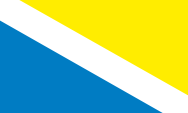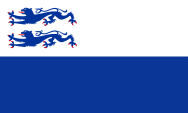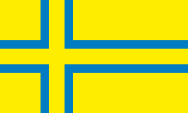|
|
| Übersicht – Contents: | |
Diese Seite ist Teil des Projektes
|
|
| Übersicht – Contents: | |
Flaggen – Flags: |
|
 |
Nordschleswig, inoffizielle Flagge – North Schleswig, unofficial flag, Seitenverhältnis – ratio = 2:3, |
 |
Nordschleswig, inoffizielle Flagge – North Schleswig, unofficial flag, Seitenverhältnis – ratio = 2:3 Quelle/Source, nach by: Flags of the World |
 |
Flagge der dänischen Region Sønderjylland |
 |
Flagge Bund Deutscher Nordschleswiger – flag of the Association of the German North Schleswiger, Seitenverhältnis – ratio = 2:3 Quelle/Source, nach by: bdn.dk |
| Für das Verständnis der Unterschiede bei den Flaggen und Wappen muss man die Perspektive der Identität nachvollziehen können. Für die einen, die deutschen Bewohner, ist es der Norden des Landes Schleswig, für die anderen, die dänischen Bewohner, ist es der Süden des Landes Jütland. Zusätzlich gab es zwischen 1970 und 2007 noch eine offizielle dänische Verwaltungsebene, das Amt Sønderjylland. Die Flagge von Nordschleswig zeigt einen diagonal von links oben nach rechts unten verlaufenden weißen Balken zwischen Gelb (oben) und Blau (unten). Die Farben gehen auf das Wappen zurück. |
The understanding of the differences in flags and coats of arms requires an
understanding of the perspective of identity. For some, the German
residents, it is the north of the country of Schleswig, for the other, the
Danish residents, it is the south of the country of Jutland. In addition,
between 1970 and 2007 there was an official Danish administrative level, the
Sønderjyllands Amt. The flag of North Schleswig shows a diagonal from the upper left to the lower right passing white bar between yellow (above) and blue (below). The colours have its roots in the coat of arms. |
| Quelle/Source: Flags of the World, Wikipedia (DA) | |
Wappen – Coat of Arms: |
|
 |
Wappen der deutschen Region Nordschleswig – coat of arms of the German North Schleswig Region, Quelle/Source, nach/by: Flags of the World |
 |
1970–2007, Wappen des Amtes Sønderjylland – coat of arms of Sønderjyllands Amt, Quelle/Source, nach/by: Erik Frohne, Public domain, via Wikimedia Commons |
| Das Wappen der deutschen Region Nordschleswig zeigt einen golden umrandeten blauen Schild, darauf zwei goldene Löwen, und die stilisierte Immerwatt-Brücke in Gold. Das Wappen von Sønderjyllands Amt zeigte einen goldenen Schild, darauf zwei blaue Löwen, die eine dänische Fahne halten. | The coat of arms of the German North Schleswig Region shows a golden bordered blue shield, on it two golden lions, and the stylized Bridge of Immerwatt in gold. The coat of arms of Sønderjyllands Amt showsed s golden shield, on it two blue lions, holding a Danish flag. |
| Quelle/Source: Flags of the World, Wikipedia (DA) | |
Landkarte – Map: |
Lage in Dänemark – Position within Denmark: |
| Quelle/Source: Morwen, CC BY-SA 3.0, via Wikimedia Commons |
| Zahlen und Fakten – Numbers and Facts: | |
|
|
|
|
|
|
|
|
|
|
|
|
|
|
|
|
|
Vorgeschichte
· siehe Schleswig 1914–1918 · Erster Weltkrieg, das Deutsche Reich unterliegt mit den Mittelmächten der Truppen der Entende 1919 · Versailler Diktatfrieden, in den Randgebieten des Deutschen Reiches in denen Minderheiten leben, werden Abstimmungsgebiete eingerichtet, in denen über Volksbefragungen über die politische Zugehörigkeit entschieden werden soll, Schleswig wird 1920 in drei Zonen unterteilt 1920 · Volksabstimmung: Zone 1 (Nordschleswig) - 74,2% für Dänemark, Zone 2 (Mittelschleswig) - 19,8% für Dänemark, in Zone 3 (Südschleswig) erfolgte keine Abstimmung, Nordschleswig kommt an Dänemark 1939–1945 · Zweiter Weltkrieg, zum Zeitpunkt der Kapitulation (7.-9.05.1945) ist Schleswig-Holstein noch zum größten Teil in der Hand der Deutschen Wehrmacht. Die Regierung des Deutschen Reiches sitzt noch bis zum 23.05.1945 in Flensburg. Nach der Demobilisierung der Wehrmachtsverbände wird die Provinz Schleswig-Holstein britisch besetzt, und am 23.08.1946 zum Land Schleswig-Holstein umgebildet 1949 · Schleswig-Holstein wird Bundesland der BRD 1955 · Deutsch-Dänische Grundsatzerklärungen 01.01.2007 · der Verwaltungskreis Nordschleswig (Sonderjylland) wird aufgelöst und geht in einer von fünf Regionen Dänemarks auf |
|
prehistory
· look Schleswig 1914–1918 · First World War, the German Empire with the Central Powers is defeated to the troops of Entende 1919 · Diktate of Versailles, in the outskirts of the German Empire, in which minorities live, become esablished in 1920 voting areas in which should make referenda about the political affiliation, Schleswig becomes divided into three zones 1920 · plebiscite, zone 1 (North Schleswig) - 74,2% for Denmark, zone 2 (Middle Schleswig) - 19,8% for Denmark, zone 3 (South Schleswig) - no plebiscite, North Schleswig comes to Denmark 1939–1945 · Second World War, at the time of surrender (7th to 9th of May in 1945), Schleswig-Holstein is to the largest parts still in the hand of the German war-might. The government of the German Empire seats still until the 23rd of May in 1945 in Flensburg. After the demobilization of the war-might squads gets the Province of Schleswig-Holstein occupied by the British, and becomes transformed to the Land of Schleswig-Holstein on 23rd of August in 1946. 1949 · Schleswig-Holstein becomes a federal country of the FRG 1955 · German-Danish Policy statements 1st of January 2007 · the Administrative District of Nord Schleswig (Sonderjylland) becomes dissolved und transformes into one of five regions in Denmark |
| Quelle/Source: 1. Wikipedia (DE); 2. Wikipedia (DE) |
| Der Name des Landes "Schleswig" geht auf die gleichnamige Stadt, die Hauptstadt des Landes zurück. Er besteht eigentlich aus zwei Teilen, "Schlei" und "wig". Schlei ist der Name des Flusses an dem die Stadt liegt, und das Wort "wig" geht auf das althochdeutsche Wort "wih" zurück, was "Ort" oder "Siedlung" heißt. Schleswig ist also die "Siedlung an der Schlei". | The name of the country "Schleswig" has its roots in the town with the same name, the capital of the country. It actually consists of two parts, "Schlei" and "wig". Schlei is the name of the river on which the town is located, and the word "wig" comes from the Old High German word "wih", meaning "place" or "housing". Schleswig is thus the "Place on the Schlei". |
| Quelle/Source: Handbuch der geographischen Namen | |
|
Mit freundlicher Untersützung von: Kindly supported by: |
Oliver Werner |